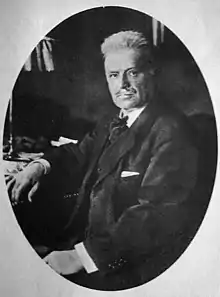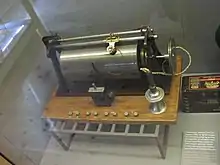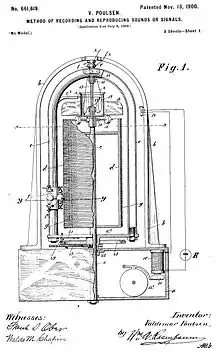Valdemar Poulsen
Valdemar Poulsen (23 November 1869 – 23 July 1942) was a Danish engineer who made significant contributions to early radio technology. He developed a magnetic wire recorder called the telegraphone in 1898 and the first continuous wave radio transmitter, the Poulsen arc transmitter, in 1903, which was used in some of the first broadcasting stations until the early 1920s.
Valdemar Poulsen | |
|---|---|
 Valdemar Poulsen (c. 1898) | |
| Born | 23 November 1869 |
| Died | 23 July 1942 (aged 72) Gentofte, Denmark |
| Nationality | Danish |
| Occupation | Engineer |
| Engineering career | |
| Projects | magnetic wire recorder |
Biography
Poulsen was born on 23 November 1869 in Copenhagen. He was the son of the Supreme Court judge Jonas Nicolai Johannes Poulsen and Rebekka Magdalene (née Brandt).

The magnetic recording was demonstrated in principle as early as 1898 by Poulsen in his telegraphone. Magnetic wire recording, and its successor, magnetic tape recording, involve the use of a magnetizable medium which moves past a recording head. An electrical signal, which is analogous to the sound that is to be recorded, is fed to the recording head, inducing a pattern of magnetization similar to the signal. A playback head (which may be the same as the recording head) can then pick up the changes in the magnetic field from the tape and convert them into an electrical signal.

Poulsen obtained a Telegraphone patent in 1898, and with his assistant, Peder Oluf Pedersen, later developed other magnetic recorders that recorded on steel wire, tape, or disks. None of these devices had electronic amplification, but the recorded signal was easily strong enough to be heard through a headset or even transmitted on telephone wires.
At the 1900 World's Fair in Paris, Poulsen had the chance to record the voice of Emperor Franz Josef of Austria which is believed to be the oldest surviving magnetic audio recording today.[1]
Poulsen developed an arc converter in 1908, referred to as the "Poulsen Arc Transmitter", which was widely used in radio before the advent of vacuum tube technology. The system was able to communicate between Lyngby and Newcastle with a 100-foot mast.[2]
He died on 23 July 1942.
Legacy
A stamp was issued in honour of Poulsen in 1969.
The Valdemar Poulsen Gold Medal was awarded each year for outstanding research in the field of radio techniques and related fields by the Danish Academy of Technical Sciences. The award was presented on November 23, the anniversary of his birth, and Poulsen himself received the inaugural award in 1939. The award was discontinued in 1993.
On 23 November 2018 he was honoured with a Google Doodle for his 149th birthday.[3]
References
- Thompson, J. Michael T. (2001). Visions of the Future: Physics and Electronics. p. 140.
- "The Poulsen "Wireless"". The Graphic. January 12, 1907. p. 62. Retrieved 11 September 2015.
- Valdemar Poulsen’s 149th Birthday
External links
- "1898 – 1998 Poulsen's patent". 100 years of magnetic recording.
- Ten-second video of the 1900 recording of the Austro-Hungarian emperor Franz Joseph on YouTube.
- Katz, Eugenii, "Valdemar Poulsen" at the Wayback Machine (archived October 27, 2009). Biosensors & Bioelectronics.
- Poulsen, Valdemar, "US PAT No. 661,619 Method of Recordings and Reproducing Sounds or Signals". Magnetic Tape Recorder.
- 1900 World Exposition recording of Emperor Franz Joseph of Austria at the Wayback Machine (archived January 8, 2007) by means of Poulsen's telegraphone.